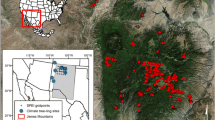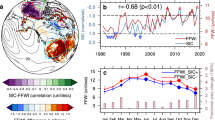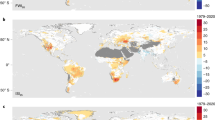Abstract
The Mediterranean climate region on the west coast of the United States is characterized by wet winters and dry summers, and by high fire activity. The importance of synoptic-scale circulation patterns (ENSO, PDO, PNA) on fire-climate interactions is evident in contemporary fire data sets and in pre-Euroamerican tree-ring-based fire records. We investigated how interannual variability in two fire weather indices, the Haines index (HI) and the Energy Release Component (ERC), in the Mediterranean region of southern Oregon and northern California is related to atmospheric circulation and fire extent. Years with high and low fire weather index values corresponded to years with a high and low annual area burned, respectively. HI combines atmospheric moisture with atmospheric instability and variation in HI was more strongly associated with interannual variation in wildfire extent than ERC, which is based on moisture alone. The association between fire extent and HI was also higher for fires in southern Oregon than in northern California. In terms of synoptic-scale circulation patterns, years of high fire risk (i.e., increased potential for erratic fire behavior, represented by HI and ERC) were associated with positive winter PNA and PDO conditions, characterized by enhanced regional mid-tropospheric ridging and low atmospheric moisture. The time lag we found between fire risk potential and prior winter circulation patterns could contribute to the development of long-lead fire-climate forecasting.







Similar content being viewed by others
References
Agee JK (1993) Fire ecology of Pacific Northwest forests. Island Press, Washington, DC
Andrade ER, Sellers WD (1988) El Niño and its effect on precipitation in Arizona and western New Mexico. J Climatol 8:403–410
Bessie WC, Johnson EA (1995) The relative importance of fuels and weather on fire behavior in subalpine forests. Ecology 76:747–762
Biswell HH (1989) Prescribed burning in California wildland vegetation management. University of California Press, Berkeley
Bradshaw L, McCormick E (2000) FireFamily Plus user’s guide, version 2.0. General Technical Report. RMRS-GTR-67WWW. Ogden, UT: USDA Forest Service, Rocky Mountain Research Station
Bradshaw LS, Deeming JE, Burgan RE, Cohen JD (1983) 1978 National Fire-Danger Rating System. Intermountain Forest and Range Experiment Station, US Department of Agriculture Forest Service Gen Tech Rep INT-169 m
Brotak EA (1993) Low-level weather preceding major wildfires. Fire Manage Notes 54:23–25
Brown DP, Comrie AC (2004) A winter precipitation ‘dipole’ in the western United States associated with multidecadal ENSO variability. Geophys Res Lett 31:L09203, DOI 10.1029/2003GL018726
Brown TJ, Hall BL, Westerling AL (2004) The impact of twenty-first century climate change on wildland fire danger in the western United States: an applications perspective. Clim Change 62:365–388
Carleton AM, Carpenter DA, Weser PJ (1990) Mechanisms of interannual variability of the southwest United States summer rainfall maximum. J Clim 3:999–1015
Chu PS, Yan W, Fujioka F (2002) Fire-climate relationships and long-lead seasonal wildfire prediction for Hawaii. Int J Wildl Fire 11:25–31
Deeming JE, Burgan RE, Cohen JD (1977) The National Fire-Danger Rating System - 1978. Gen. Tech. Rep. INT-39, USDA Forest Service Intermountain Forest and Range Experiment Station, pp 63
Dettinger MD, Cayan DR, Diaz HF, Meko DM (1998) North–South precipitation patterns in western North America. J Clim 11:3095–3111
Flannigan MD, Harrington JB (1988) A study of the relation of meteorological variables to monthly provincial area burned by wildfire in Canada 1953–80. J Appl Meteorol 27:441–452
Garcia Diez EL, Rivas Soriano L, De Pablo Davila F, Garcia Diez A (1994) An objective forecasting model for the daily outbreak of forest fires based on meteorological conditions. J Appl Met 33:519–526
Garcia Diez EL, Rivas Soriano L, De Pablo Davila F, Garcia Diez A (1999) Prediction of the daily number of forest fires. Int J Wildl Fire 9:207–211
Gedalof Z, Peterson DL, Mantua NJ (2005) Atmospheric, climatic and ecological controls on extreme wildfire years in the northwestern United States. Ecol Appl 15:154–174
Gershunov A, Barnett TP (1998) Interdecadal modulation of ENSO teleconnections. Bull Am Meteor Soc 79:2715–2725
Gershunov A, Barnett TP, Cayan DR (1999) North Pacific Interdecadal Oscillation seen as factor in ENSO-related North American climate anomalies. EOS Trans Am Geophys Union 80:25–36
Haines DA (1988) A lower atmospheric severity index for wildland fires. Natl Wea Dig 13:23–27
Hessl AE, McKenzie D, Schellhaas R (2004) Drought and Pacific decadal oscillation linked to fire occurrence in the inland Pacific Northwest. Ecol Appl 14:425–442
Heyerdahl EK, Brubaker LB, Agee JK (2002) Annual and decadal climate forcing of historical fire regimes in the Interior Pacific Northwest, USA. Holocene 12:597–604
Johnson EA, Wowchuk DR (1993) Wildfires in the southern Canadian Rocky Mountains and their relationship to mid-tropospheric anomalies. Can J For Res 23:1213–1222
Kalnay E, Kanamitsu M, Kistler R, Collins W, Deaven D, Gandin L, Iredell M, Saha GS, White JW, Zhu Y, Leetmaa A, Reynolds B, Chelliah M, Ebisuwaki W, Higgins W, Janowiak J, Mo KC, Ropelewski C, Wang J, Jenne R, Joseph D (1996) The NCEP/NCAR 40-year reanalysis project. Bull Am Meteorol Soc 77:437–471
Kaplan A, Cane M, Kushnir Y, Clement A, Blumenthal M, Rajagopalan B (1998) Analyses of global sea surface temperature 1856–1991. J Geophys Res 103:18567–18589
Kasischke ES, Turetsky MR (2006) Recent changes in the fire regime across the North American boreal region—spatial and temporal patterns of burning across Canada and Alaska. Geophys Res Lett 33:L09703, DOI 10.1029/2006GL025677
Kitzberger T (2002) ENSO as a forewarning tool of regional fire occurrence in northern Patagonia, Argentina. Int J Wildl Fire 11:33–39
Kohonen T (1989) Self-organization and associative memory. Springer, Berlin Heidelberg New York, p 312
Leathers DJ, Yarnal B, Palecki MA (1991) The Pacific/North American Teleconnection Pattern and United States Climate. Part I: Regional Temperature and Precipitation Associations. J Clim 4:517–528
Lupo AR, Oglesby RJ, Mokhov II (1997) Climatological features of blocking anticyclones: a study of Northern Hemisphere CCM1 model blocking events in present-day and double CO2 concentration atmosphere. Clim Dyn 13:181–195
Main WA, Paananen DM, Burgan RE (1990) Fire Family Plus. North Central Forest Experiment Station, USDA Forest Service Gen Tech Report NC-138
Mantua NJ, Hare SR, Zhang Y, Wallace JM, Francis RC (1997) A Pacific interdecadal climate oscillation with impacts on salmon production. Bull Am Meteor Soc 78:1069–1079
McCabe GJ, Dettinger MD (1999) Decadal variations in the strength of ENSO teleconnections with precipitation in the western United States. Int J Clim 19:1399–1410
Meehl GA, Tebaldi C (2004) More intense, more frequent, and longer lasting heat waves in the 21st century. Science 305:994–997
Palmer WC (1965) Meteorological drought Research Paper 45. U.S. Dept of Commerce, Washington, DC, p 58
Pereira MG, Trigo RM, da Camara CC, Pereira JMC, Leite SM (2005) Synoptic patterns associated with large summer forest fires in Portugal. Agr For Meteor 129:11–25, DOI 10.1016/jagrformet.2004.12.007
Peterson TC, Vose RS (1997) An overview of the Global Historical Climatology Network temperature data base. Bull Am Meteor Soc 78:2837–2849
Potter BE (1996) Atmospheric properties associated with large wildfires. Int J Wildl Fire 3:131–138
Richman MB (1986) Rotation of principal components. J Climatol 6:293–335
Rorig ML, Ferguson SA (1999) Characteristics of lightning and wildland fire ignition in the Pacific Northwest. J Appl Met 38:1565–1575
Saltenberger J, Barker T (1993) Weather related unusual fire behavior in the Awbrey Hall Fire. Natl Wea Dig 19:20–29
Skinner CN, Chang C (1996) Fire regimes, past and present. Sierra Nevada Ecosystem Project: Final Report to Congress vol. 2, Assessments and scientific basis for management options. University of California Centers for Water and Wildland Resources, Davis, CA, pp 1041–1069
Skinner WR, Stocks BJ, Martell DL, Bonsal B, Shabbar A (1999) The association between circulation anomalies in the mid-troposphere and area burned by wildland fire in Canada. Theor Appl Climatol 63:89–105
Skinner WR, Todd JB, Flannigan MD, Martell DL, Stocks BJ, Wotton BM (2002) A 500-mb synoptic wildland fire climatology from large Canadian forest fires, 1959–1996. Theor Appl Climatol 71:157–169
Skinner WR, Shabbar A, Flannigan MD, Logan K (2006) Large forest fires in Canada and the relationship to global sea surface temperatures. J Geophys Res 111:D14106, DOI 10.1029/2005JD006738
Swetnam TW (1993) Fire history and climate change in giant sequia groves. Science 262:885–889
Swetnam TW, Betancourt JL (1990) Fire-Southern Oscillation relations in the southwestern United States. Science 249:1017–1020
Swetnam TW, Betancourt JL (1998) Mesoscale disturbance and ecological response to decadal climatic variability in the American Southwest. J Clim 11:3128–3147
Taylor AH, Beaty RM (2005) Climatic influences on fire regimes in the northern Sierra Nevada Mountains, Lake Tahoe Basin, Nevada, USA. J Biogeogr 32:425–438
Taylor AH, Trouet V, Skinner CN (2008) Climatic influences on fire regimes in montane forests of the southern Cascades, California, USA. Int J Wildl Fire 17:60–71, DOI 10.1071/WF07033
Trouet V, Taylor AH, Carleton AM, Skinner CN (2006) Fire-climate interactions in forests of the American Pacific coast. Geophys Res Lett 33:L18704, DOI 10.1029/2006GL027502
Van Oldenborgh GJ, Burgers G (2005) Searching for decadal variations in ENSO precipitation teleconnections. Geophys Res Lett 32:L15701, DOI 10.1029/2005GL023110
Verdon DC, Kiem AS, Franks SW (2004) Multi-decadal variability of forest fire risk -Eastern Australia. Int J Wildl Fire 13:165–171, DOI 10.1071/WF03034
Wallace JM, Gutzler DS (1981) Teleconnections in the Geopotential Height Field during the northern hemisphere winter. Mon Wea Rev 109:784–812
Warren JR, Vance DL (1981) Remote Automatic Weather Station for Resource and Fire Management Agencies. Tech. Rep. INT-116, USDA Forest Service, Intermountain Forest and Range Experiment Station
Weatherspoon CP, Skinner CN (1996) Landscape-level strategies for forest fuel management. Sierra Nevada Ecosystem Project: Final report to Congress, Wildland Resources Center Report No. 37, Centers for Water and Wildland Resources, University of California, pp 1471–1492
Werth PA, Ochoa R (1993) The evaluation of Idaho wildfire growth using the Haines index. Wea Forecasting 8:223–234
Werth J, Werth P (1998) Haines index climatology for the western United States. Fire Manage Notes 58:8–17
Westerling A, Swetnam T (2003) Interannual to decadal drought and wildfire in the western United States. EOS 84:545–560
Winkler JA, Potter BE, Wilhelm DF, Shadbolt RP, Piromsopa K, Bian XD (2007) Climatological and statistical characteristics of the Haines index for North America. Int J Wildl Fire 16:139–152
Acknowledgements
This research was supported by a cooperative agreement with the USDA Forest Service, Pacific Southwest Research Station (04-JV-11272162-407) from funds provided by the USDI/USDA Interagency Joint Fire Sciences Program and a George S. Deike Research Grant. We thank Brian Potter, Julie Winkler, and Ryan Shadbolt for providing us with the Haines index data set and for helpful suggestions about its application.
Author information
Authors and Affiliations
Corresponding author
Rights and permissions
About this article
Cite this article
Trouet, V., Taylor, A.H., Carleton, A.M. et al. Interannual variations in fire weather, fire extent, and synoptic-scale circulation patterns in northern California and Oregon. Theor Appl Climatol 95, 349–360 (2009). https://doi.org/10.1007/s00704-008-0012-x
Received:
Accepted:
Published:
Issue Date:
DOI: https://doi.org/10.1007/s00704-008-0012-x




